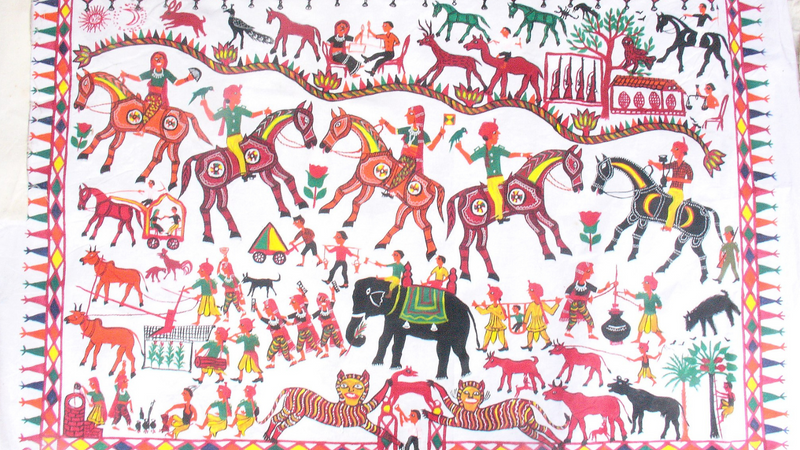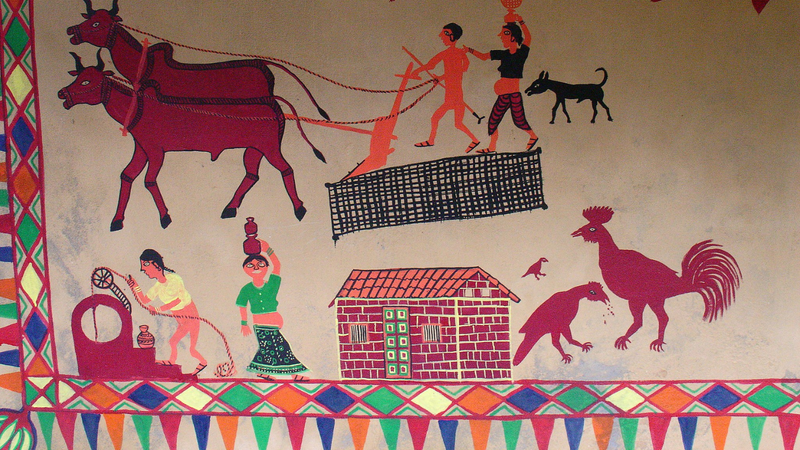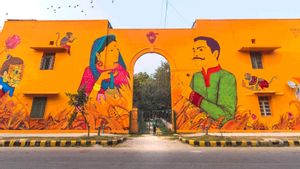Snapshots
India’s tribal settlements are replete with some magical mysteries. They open up a deep understanding of our country’s heritage and culture. The folk art of Pithora painting in Madhya Pradesh and Gujarat is one of the few testimonies to India’s many guarded secrets. These colourful creations are rooted in a deep reverence for nature and spirituality, primarily of the Bhil tribe. Not just that, the depictions often demarcated an auspicious event happening within the tribal community. On the way to total obscurity, the Pithora artwork has very few artists dedicated to its practice today. This powerful storytelling tool needs to live on as a reminder of India’s rich cultural history. Read on to know more about this beautiful art form.
What are Pithora paintings?
At first glance, it may seem like the Pithora art is nothing more than just painting. However, its origins go beyond that. Most people recognise Pithora as a ritual, an act performed in gratitude for the many mystical forces around the artist. It is often believed that not everyone in the Bhil tribe was allowed to create a Pithora artwork. Only individuals who were connected to the divine spiritual forces, and could channel into their creations, painted these Rathwa paintings. Apart from that, a part of this ritual was the ‘granting of a wish’. The Badwa or the priest of the village community would offer solutions to people in distress. Often, they were advised to paint Pithoras over walls in their homes. This would be their offering to the Pithora Baba, a village deity.

What are the other rituals behind the folk art of Pithora paintings?
There are several stories that are affiliated with the creation of Pithora paintings. It is believed that the tribes who engage in creating the folk art of Pithora painting do it only after Diwali and only if they have had a good harvest. This shows how painting Pithoras is associated with prosperity. Moreover, most paintings are believed to depict another deity - Pithora. It is believed that painting him in a home would bring good luck and prosperity. So often, one can find these designs on a house’s threshold. While Pithoras are painted in celebration, they are also painted after an extreme misfortune.
Unlike most prehistoric art forms, the Pithora paintings are the result of a community effort. In the Bhil tribe, there are artists who create the paintings and there are those who survey them. While the former is known as lakara, the latter is labelled jhokara. Then, there is the priest (badwa) who not only makes the suggestions but also sings and chants while the painting is being created. It just goes to show how strong their faith in their deities is. The badwa also makes sure that the Pithora is up to mark and suggests changes wherever necessary.
Where is the folk art of Pithora paintings from?
The Pithora art is a common practice amongst four Indian tribes - the Rathwas, Bhil tribe, Tadis and Naykas. These tribes live in the forests of Gujarat, Rajasthan and Madhya Pradesh. Their grounded lifestyles and rural settlements are reflected in these Rathwa paintings. These tribes used only naturally-sourced colours made from pigments retrieved from plants or stones.

What is the technique of the Pithora painting?
The most unique aspect of creating a Pithora Rathwa painting is the colours used. Tribals often mixed milk and alcohol with naturally-sourced pigments. The alcohol was obtained from a deeply revered Mahuda tree. Apart from that, the artists also used cow dung and charcoal. Minerals such as hematite and malachite were ground to obtain colours such as red or green. These genius artists chewed on twigs (mainly bamboo shoots) to create a brush. The figures were drawn in black using charcoal and filled with colours. To ensure that their canvas was even, artists added a layer of cow dung to the walls. There is a strict rule in the community that the paintings be prepared by unmarried girls. Also known as kumaris, they smear cow dung mixed with clay and the process takes about 7 days. Since they use white clay, most backgrounds of Pithora paintings have a whitish shade. One of the main reasons they use this white clay or Pandurya is its purifying properties. The Rathwa tribe mainly believes that this particular clay is sacred. Primarily, you will find blues, reds, yellows and greens being used in most Pithora paintings. These colours were then mixed to create more shades.
What are the themes of the Pithora paintings?
Most Pithora art of the Bhil community focuses on the deity Pithoro, primarily on events surrounding his wedding. He is believed to be the sacred guardian of the community’s food. He is often painted in white alongside his wife Pithorani. The couple is often the main character of every Pithora painting. This also explains why most Pithora paintings are seen on the main wall of the house. The tribals believe that Pithoro will protect them from famine and bring prosperity to their homes. Apart from that, the artwork focused on natural elements like the animals or the plants around. Often, you will also see planets and stars speckled all over these paintings.

However, if you ever look at a Pithora painting closely, you will see that horses dominate most of them. This is because the versatile animal was considered sacred by the tribals. The animal represents their ancestors and deities. If you ever come across a painting with seven horses, know that they are used to represent the seven hills around their villages. Along with this, most Pithora paintings served as maps. This art form is considered one of the oldest ways to make maps. The tribals often helped traders navigate through the tricky forests and in order to keep it a secret, they invented secret maps. No one but the members of these tribes would know what a painting represented. Some Pithora paintings of the Rathwa and Bhil communities also depicted important ceremonies such as festivals and weddings. If you zoom out, you will see the vivid representation of nature in these paintings, amplifying the tribals’ connectivity with the energies around them.
Are there Pithora artists today?

The Rathwa and Bhil community’s prehistoric art of Pithora is slowly dying or growing into a changed modern concept. For instance, synthetic colours have replaced natural dyes and artists are opting for paintbrushes. While art enthusiasts are appreciating and inculcating this intricate art, its essence is fading. Today, the ritual has been boiled down to just another form of painting. However, there is hope that its story will only get stronger over time and it will be seen and respected for what it is - a sacred ritual. A lot of up-and-coming art institutions and exhibitions have put the Pithora art on display. These creations are being witnessed, not just within the country, but internationally as well.
Curious to know more about this unique art form? You can check out traditional Indian paintings at the India Art Fair 2023. The exclusive exhibition in Delhi features contemporary renditions of traditional art forms and a take of Pithora paintings is bound to be there. Another space to experience traditional Indian and prehistoric art is the Kiran Nadar Museum of Art.
If visual creations and colourful displays of creativity are your things, the Dior Couture show might also interest you.
Disclaimer: The details mentioned throughout this blog are sourced from publicly accessible platforms. At Zeezest, we intend to share factual and verified information. Should there be any inconsistencies or variances in the information provided, please understand that these are entirely unintentional and not meant to mislead.


_1674447537629_thumb_1200.png?w=3840&q=75)

